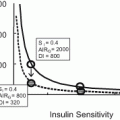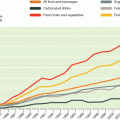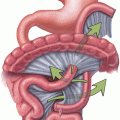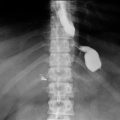© Springer Science+Business Media New York 2015
Adrienne Youdim (ed.)The Clinician’s Guide to the Treatment of ObesityEndocrine Updates10.1007/978-1-4939-2146-1_44. Dietary and Lifestyle Strategies for Weight Loss
(1)
Change My Eating, Inc., 861 North Vista Street, 90046 Los Angeles, CA, USA
Keywords
Weight managementBehavior changeSelf-efficacy strategiesSelf-managementThe combination of dietary modification, increased physical activity, and behavioral therapy is the most effective nonsurgical obesity treatment available [1]. The US Preventative Services Task Force is recommending that clinicians refer obese individuals to “intensive, multicomponent behavioral interventions” and is consequently a mandate under the Affordable Care Act [2, 3]. Additionally, the Centers for Medicare and Medicaid Services recently added a provision calling for “intensive behavioral counseling” to obese seniors [4]. As a result of these national changes, health-care providers familiarizing themselves with the fundamentals of behavioral therapy is apropos and will be outlined as such in this chapter.
Defining Lifestyle Modification
Lifestyle modification programs are composed of caloric restriction, physical activity expenditure, and behavioral therapy. The overriding feature of behavioral therapy is to help patients develop specific strategies to increase compliance with diet and exercise [5–7]. The short-term treatment traditionally involves attendance of 20–26 weekly group meetings yielding a mean weight loss of 9 % (8.5 kg). Losing 5–10 % of initial weight is a goal set forth by the Institute of Medicine of the National Academy of Sciences, the World Health Organization, and the National Heart, Lung and Blood Institute to ultimately improve obesity-associated comorbidities [8]. Educating patients regarding these modest weight loss targets may help alleviate their dissatisfaction with their weight losses and prevent possible premature forfeiture of their participation.
The traditional characteristics of behavioral treatment are multiple and include food and activity journaling, frequent weigh-ins, caloric restriction through consumption of low-energy-dense foods, high levels of physical activity , improved food environments, problem-solving and cognitive therapy. Skilled providers of behavioral therapy guide patients to identify what behavior needs changing with examination of possible elements that may help or hinder goal attainment. This process-oriented, patient-centered approach is collaborative and a defining feature of motivational interviewing, a form of therapy used in the behavioral treatment of obesity [9].
Well-known investigators, such as the Diabetes Prevention Program research group (DPP), afforded evidence that behavioral treatment is valid and reliable [10]. The DPP’s purpose was to evaluate the effectiveness of lifestyle interventions in reducing the incidence of prediabetic individuals from progressing to type II diabetes mellitus. This randomized, controlled intervention involved over 3000 obese individuals in 27 centers across the country. The lifestyle intervention group was able to reduce the incidence of diabetes by 58 %, outperforming the metformin and placebo counterparts. As a result of these impressive results, YMCAs across the country offer DPP programs for prediabetic individuals.
The Look AHEAD (action for health in diabetes) study similarly depicts the effectiveness of lifestyle interventions [11]. This study is considered the largest prospective, ethnically diverse lifestyle intervention to date. The study authors recruited over 5000 men and women at 16 different centers with type II diabetes mellitus and randomly assigned them to one of the two groups: the intensive lifestyle intervention group or the control group. The lifestyle intervention group participated in 42 group and/or counseling sessions over a year’s time, while the control group met only three times for educational sessions. The intensive lifestyle group was able to achieve the gold standard with weight loss—just over 8 %, while the control group was unable to achieve significant weight losses.
Treatment Delivery
Lifestyle modification programs can be delivered in groups, one-on-one sessions, or a combination of both. Sessions typically meet weekly in 60–90-minute intervals and are facilitated by registered dietitians (RDs), behavioral psychologists, and/or exercise specialists. The group may begin with a didactic component, with presentation of a nutrition/behavioral topic, followed by planning for the upcoming week [12]. The meeting’s focus is program adherence, problem-solving specific steps to accomplish desired behaviors, relapse prevention, and recovery in addition, to review of alternative coping strategies exclusive of food.
Groups
Facilitating patients to support each other in a group process can be effective in getting patients to change their behavior, as well as taking some of the burden off the provider. Other benefits to the group process include helping patients not feel alone with their weight struggle, reducing the cost of individual appointments typically not covered by insurance, and increasing patients’ motivation to comply as their weight change is made public during meetings [12]. This accountability and support is what attracts patients to these groups. Perri and colleagues demonstrated significantly greater weight reductions in subjects when behavioral therapy was conducted in groups versus individually [13].
Additionally, group commercial weight loss programs enhanced induction of clinically significant weight losses in the Lighten Up Study. This randomized controlled trial compared one-on-one counseling sessions conducted in primary care offices to group commercial weight loss programs in over 700 subjects. The study authors suspect the primary care providers’ less than superior results may have been due in part to the missing group dynamic. [14].
Remote Support
Appel et al. recently found remote support equally effective at producing clinically significant weight losses in obese subjects when compared with in-person behavioral treatment [17]. Both the in-person and remote support patients attended follow-up visits at 6, 12, and 24 months with the primary care physician (PCP) where they were weighed and provided guidance on their computer-generated report accessed from the website. Trained weight loss coaches worked in collaboration with the PCP in delivering group or individual sessions to the in-person intervention, while those in the remote support intervention were counseled via telephone. The delivery of the behavioral counseling, not the frequency, was the defining characteristic between the two interventions.
At the conclusion of 2 years, the weight change from baseline was 1.1 % in the control group, 5 % receiving remote support, and 5.2 % in the group receiving in-person treatment. These results demonstrate that the remote behavioral counseling can be just as effective as face-to-face counseling in achieving clinically significant weight losses.
Internet behavioral counseling was also compared to standard Internet treatment. All participants were asked to submit their weight and food records via a web-based diary. Email reminders were submitted weekly for the entire 12 months of the study. The behavioral counseling group received feedback on their food records, reinforcement for identified behaviors, and recommendations for change. At 12 months, the addition of e-counseling doubled the percentage of initial weight loss from 2.2 to 4.8 % [18] compared to the standard treatment group.
The paradigm of remote counseling with reinforcement has far-reaching implications. Consider the patient’s reduced burden from missing time from work, finding and paying for a parking space, and cost of commuting. While more studies are needed to confirm its effectiveness, this and other recent studies are promising.
Weight Loss Surgery Candidates
Although surgical weight losses produce the maximum results, not every patient is a candidate for weight loss surgery or open to this type of intervention. Furthermore, the realities of weight regain after bariatric surgery have been demonstrated [19]. Encouraging surgical patients both pre- and postoperatively to practice specific lifestyle interventions may help bode for a more successful outcome and dismiss patient’s false belief that surgery will “cure their obesity” and reduce postsurgical complications [20].
A randomized controlled trial found Hispanic subjects who received “comprehensive nutrition and lifestyle education” sessions experienced significantly greater excess weight losses at 1 year following, gastric bypass than their control counterparts [21]. Additionally, postoperative gastric bypass subjects who engaged in dietary self-monitoring were less likely to suffer from weight regain [22, 23]. Further studies are needed that examine the impact of lifestyle modification on pre- and postsurgery subjects since there are a limited number of well-designed randomized controlled trials [24].
Choose Your Words Wisely
It is important to put yourself in the shoes of the patient, especially since negative biases from health-care providers towards their obese patients have been demonstrated [7]. Barbara Rolls [25] and her colleagues from the Department of Nutritional Science at Pennsylvania State University found that subjects are more apt to change their behavior after hearing what to do in lieu of what not to do. Two types of messages were delivered to two randomly assigned groups of obese women. The first group of women was counseled to reduce their fat intake, while the second group was advised to increase the energy density of their diet. Energy density is the amount of total calories of a food, related to its weight. Influencers of food’s energy density include water, fiber, and fat. Fruits and vegetables are a mainstay of low-energy-dense or low-calorie diets.
Throughout the year, both groups received individualized counseling with weigh-ins and participated in group lessons consisting of holiday eating, label reading, dining out, grocery shopping, and recipe modification. Both groups were asked to keep food records and these records were reviewed individually with the dietitian.
Significant weight losses were achieved in both groups. However, the group that was advised to add more water-rich foods, was able to lose 33 % more weight at 6 months compared to the group coached in the more traditional restrictive messages to eat less. Additionally, records kept by the participants indicated that those who ate more water-rich foods consumed 25 % greater food by weight and experienced less hunger than those on the reduced fat approach. The authors speculate that the increased compliance was also attributable to the increased satiety from the high volume of food consumed.
This study coincides with American beliefs reported in the International Food Information Council Foundation in which 78 % of Americans identified themselves as preferring to hear what they should eat rather than what they should not eat [26].
A smaller-scale study done by Epstein [27] and colleagues found encouraging consumption of fruit and vegetables to families with children at high risk of obesity experienced better outcomes, compared to the group who received messages to decrease their fat and sugar intake. Interestingly, the parents of the high-risk children, not the children, experienced significant weight losses and increased their fruit and vegetable intake by approximately three servings per day; in contrast to their low-fat, low-sugar group counterparts.
Self-monitoring With Food Journaling
Self-monitoring is the cornerstone of many weight loss interventions. Albert Bandera, the father of social cognitive theory (SCT), asserts that self-monitoring is a process which forces us to pay attention to our own behavior. SCT assumes that without this focus, undesired actions, such as eating foods that we otherwise would not eat or know we should not eat, cannot be modified. Ultimately, self-monitoring promotes self-regulation [28]. A meta-analysis published in the Journal of the American Dietetic Association reviewed the effectiveness of dietary self-monitoring and its effects on weight loss in 15 studies. Associations between self-monitoring and weight loss were consistently found. As one might estimate, weight losses are highly correlated with frequent and more thorough food records [29, 30].
Dietary Self-monitoring Using Technology
While self-monitoring is effective, providers need strategies to increase compliance with this essential behavior. Self-monitoring using technology is one recently identified strategy. As of now, greater weight losses occur when remote technology is added to in-person patient provider contact [31–33].
Lora Burke and her colleagues discovered increased compliance with food recording using personal digital assistants (PDAs). This advantage was noted to be most beneficial in the first 6 months of the study, where PDA users self-monitored 80–90 % of the time, compared to their paper recording counterparts who only self-monitored 55 % of the time [16].
The greatest adherence and weight losses were witnessed in the group that received personalized feedback messages through the PDA platform. PDA messages were tailored to the individual and included such reminders as “taking a few minutes to record will help you meet your goals” or “watch portion sizes to control calories.” All study groups (paper method, PDA, and PDA with feedback) experienced some weight regain in the 2nd year of the study, with the least amount in the PDA with feedback. The authors concluded that the additive coaching may have been responsible for the superior results.
Similar results were published in the Journal of Internal Medicine where predominantly male subjects were randomized into a technology or standard intervention group [34]. The technology group received coaching calls, was advised to record food intake throughout the day via their PDA, and attended behavioral classes led by a psychologist, dietitian, or physician. The standard group did not receive coaching calls but tracked their food via paper method and attended group meetings. The technology group achieved and sustained significantly greater weight losses contrasted with the standard group. This benefit occurred for the remainder of the study (7–12 months), even after cessation of the coaching calls. The enhanced weight losses may have been due to the combination of individualized coaching calls and tracking technology.
Using technology to increase compliance of self-monitoring shows promise and is aligned with our technology-centered world. Once patients learn how to self-monitor using specific apps and software, most of them are relieved at the ease of entering their food. They have access to a large database of foods; foods are subtotaled as they are entered and the ability to reach calorie and protein goals are concretely assessed on a day-to-day basis. Additional benefits include easy retraction of frequently eaten meals and portability of the “paperless notebook” in the event a smart phone or tablet is used.
According to SCT, not all patients possess the “behavioral capability” to perform self-monitoring effectively. This process of skills training may need to be part of in-clinic consultations or group meetings.
Another strategy to increase compliance with self-monitoring and behavior change , in general, may be reminding patients they do not have to be perfect. Patients hold themselves to very high standards and this “perfectionist” mentality may often be a barrier to change or managing unexpected setbacks. In Lora Burke’s study [16], subjects who adhered to food recording 30–59 % of the time were nonetheless able to lose significant weight. Consistency with self-monitoring should ultimately be the focus, as this will have the greatest impact with weight loss. However, benefits are achieved even when our patients have not been compliant all the time. Studies have shown that early compliance (with self-monitoring and attendance) predicts long-term weight losses in the POUNDS LOST study (prevention of obesity using novel dietary strategies) [35].
Improving Underreporting of Food Intake
It is estimated that underreporting is more common in the obese population, which have been known to underestimate their caloric intake by as much as 20–40 % [7]. These uncounted calories could prevent patients from losing weight. While meal replacements may help alleviate some of these errors, it is desirable for patients to improve upon their ability to estimate portion sizes. Several researchers have invariably found improvements in reporting errors with specialized self-monitoring training [36]. The various teaching media include food models, food photographs, illustrations or graphs. A focus group acknowledged that this type of food estimation training improved their comfort in reporting less socially desirable food choices. The goal of this specialized training is to mitigate underreporting errors, not necessarily ameliorate this phenomenon. A registered or licensed dietitian professional is highly skilled at this type of instruction.
Self-monitoring With Weighing
Similar to self-monitoring of food consumed, regular weighing can both slow weight regain and facilitate weight losses. While the necessary frequency is debated, individuals who weigh at least once weekly can more quickly identify a lapse or obtain reinforcement for a behavioral accomplishment. The Institute of Medicine of the National Academy of Sciences, the World Health Organization, and the National Heart, Lung and Blood Institute all recommend regular weighing to help ensure long-term weight maintenance [1].
A review article by VanWormer and colleagues examined the evidence of 12 studies that included frequent self-weighing. They concluded from 11 out of the 12 studies that frequent self-weighing is a good predictor of moderate weight loss and weight maintenance. This is true for both for individuals who have lost weight and are attempting to keep it off, and for individuals who are attempting to avoid weight gain in the first place [37, 38].
The Health Works trial examined the efficacy of preventing weight gain via frequent weighing. Six worksites with more these 250 employees in the Minneapolis area were recruited. Three of the worksites received a weight gain prevention intervention and the other three worksites received no treatment. Weights were measured at baseline and 24-month follow-up. The intervention group had access to stations with scales where they recorded and submitted their weight into a locked box. At 2-year follow-up, monthly self-weighers ended up gaining weight, while daily self-weighers experienced the greatest weight losses [39].
The study to prevent regain (STOP) tested the efficacy of weekly weighing as a self-regulation strategy to prevent weight regain after significant weight loss. Over 300 subjects who had lost at least 10 % of their initial body weight within 2 years prior were recruited to either a face-to-face intervention, Internet intervention, or control group. Both intervention groups were given a scale, weighed and submitted their weekly weight through the telephone or Internet. They were taught to compare their maintenance start weight with their current weight. If they had gained more than 3 pounds, they were instructed to use the weight loss approach that afforded them the initial weight loss or a standard behavioral approach.
Both groups attended weekly meetings in the first month and then monthly thereafter throughout the 18-month study. The Internet group participated in their meetings via a chat room led by the same nutritionist, exercise physiologist, and clinical psychologist who led the face-to-face group. Clinic assessments occurred for all groups at 6, 12, and 18 months. During the 18-month period, 72 % of the control group regained greater than 5 pounds, compared with only 54.8 % in the Internet group and 45.7 % in the face-to-face group. While the face-to-face group produced the most superior results, the Internet intervention should be considered a viable option to help patients prevent weight regain [40].
Stay updated, free articles. Join our Telegram channel

Full access? Get Clinical Tree







